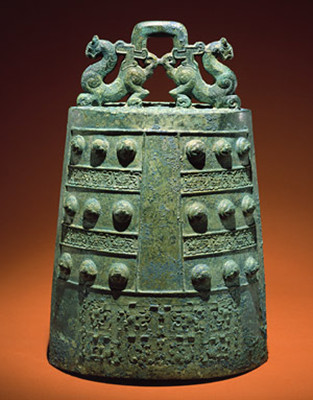The bell here at the British Museum is large and very handsome.
大英博物館的銅鐘外形碩大美觀。
It's about the size of a beer barrel, but is not circular, but elliptical.
如啤酒桶大小的它截面呈橢圓形。
In fact, it reminds me of nothing so much as an outsize Swiss cowbell.
令人聯想起一只超大的瑞士牛鈴。
Nonetheless, it's a pretty impressive sight.
鐘身雕刻精美,
It's covered in decoration, elaborate strap-work that swirls all over, round medallions with dragons' heads swallowing geese and, at the top, two magnificent standing dragons holding the handle from which the bell would have hung.
通體環繞帶狀花紋,圓形浮雕上刻有吞食大雁的龍頭,頂部盤踞著兩條華美的龍,組成懸掛銅鐘的把手。
This was a bell that was not only made to be heard, but to be seen.
這樣的銅鐘,能給人聽覺與視覺的雙重享受。
Like the Hong Kong bells we heard earlier on, our bell would have originally been part of a set owned by a warlord or by a powerful official in one of the numerous small states.
這銅鐘原本是成套的,主人可能是當時的諸侯,也可能是某個諸侯國的大臣。
Owning a set of bells-and, even more, being able to afford the orchestra to play them-were visible, and of course audible, signs of great wealth and status.
擁有一套銅鐘,并擁有一整支能演奏它們的樂隊,無疑是財富與地位的象征。
The principal message of our bell would have originally been about its owner's power, but it would also have represented that owner's view of society and the cosmos.
銅鐘所傳達的主要信息便是主人的權勢,但同時它也能表現出主人的社會觀與宇宙觀。












